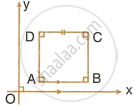Advertisements
Advertisements
Question
Show that points P(1, –2), Q(5, 2), R(3, –1), S(–1, –5) are the vertices of a parallelogram.
Solution
Let, P(1, −2) = (x1, y1); Q(5, 2) = (x2, y2); R(3, −1) = (x3, y3) and S(−1, −5) = (x4, y4).
By distance formula,
PQ = `sqrt((x_2 - x_1)^2 + (y_2 - y_1)^2)`
= `sqrt((5 - 1)^2 + [2 - (-2)]^2)`
= `sqrt((4)^2 + (4)^2)`
= `sqrt(16 + 16)`
= `sqrt32`
= `sqrt(2 xx 2 xx 2 xx 2 xx 2)`
= `4sqrt2` ...(1)
QR = `sqrt((x_3 - x_2)^2 + (y_3 - y_2)^2)`
= `sqrt((3 - 5)^2 + (-1 - 2)^2`
= `sqrt((-2)^2 + (-3)^2)`
= `sqrt(4 + 9)`
= `sqrt13` ...(2)
RS = `sqrt((x_4 - x_3)^2 + (y_4 - y_3)^2)`
= `sqrt((-1 - 3)^2 + [-5 - (-1)]^2)`
= `sqrt((-4)^2 + (-4)^2)`
= `sqrt(16 + 16)`
= `sqrt32`
= `sqrt(2 xx 2 xx 2 xx 2 xx 2)`
= `4sqrt2` ...(3)
PS = `sqrt((x_4 - x_1)^2 + (y_4 - y_1)^2)`
= `sqrt((-1 - 1)^2 + [-5 - (-2)]^2)`
= `sqrt((-2)^2 + (-5 + 2)^2)`
= `sqrt((-2)^2 + (-3)^2)`
= `sqrt(4 + 9)`
= `sqrt13` ...(4)
In `square`PQRS,
PQ = RS ...[From (1) and (3)]
QR = PS ...[From (2) and (4)]
`square`PQRS is a parallelogram. ...(A quadrilateral is a parallelogram if both the pairs of its opposite sides are congruent.)
Points P(1, –2), Q(5, 2), R(3, –1), S(–1, –5) are the vertices of a parallelogram.
RELATED QUESTIONS
Find the slope of the line parallel to AB if : A = (−2, 4) and B = (0, 6)
The side AB of a square ABCD is parallel to the x-axis. Find the slopes of all its sides. Also, find:
- the slope of the diagonal AC.
- the slope of the diagonal BD.

Lines 2x – by + 5 = 0 and ax + 3y = 2 are parallel to each other. Find the relation connecting a and b.
If the lines y = 3x + 7 and 2y + px = 3 are perpendicular to each other, find the value of p.
Determine whether the following point is collinear.
R(1, –4), S(–2, 2), T(–3, 4)
If A(1, –1), B(0, 4), C(–5, 3) are vertices of a triangle then find the slope of each side.
Find k, if R(1, –1), S (–2, k) and slope of line RS is –2.
Find the slope of the diagonals of a quadrilateral with vertices A(1, 7), B(6, 3), C(0, –3) and D(–3, 3).
Find the slope of a line, correct of two decimals, whose inclination is 60°
Find the slope of a line parallel to the given line x +3y = 7
Find the slope of a line parallel to the given line 5x-y = 10
Find the value of a line perpendicular to the given line 5x+2y-9 = 0
Find the Slope of the line having inclination 45°.
Given that (a, 2a) lies on line`(y)/(2) = 3 - 6`.Find the value of a.
A line passing through the points (a, 2a) and (- 2, 3) is perpendicular to the line 4a + 3y + 5 = 0. Find the value of a.
Show that the line joining (2, – 3) and (- 5, 1) is:
(i) Parallel to line joining (7, -1) and (0, 3).
(ii) Perpendicular to the line joining (4, 5) and (0, -2).
The line through P (5, 3) intersects Y axis at Q.
(i) Write the slope of the line.
(ii) Write the equation of the line.
(iii) Find the coordinates of Q.
The vertices of a triangle are A(10, 4), B(- 4, 9) and C(- 2, -1). Find the
Find the slope of the line passing through given points G(3, 7) and K(–2, –3).
